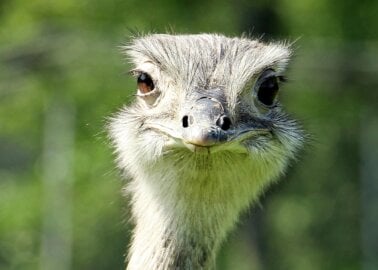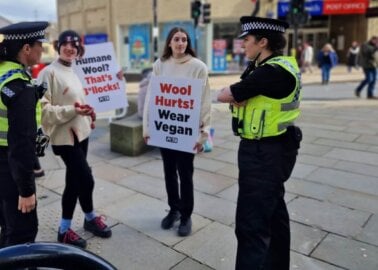These Countries Have Banned Fur Farming – Which One Will Be Next?
Take a look at the nations that have embraced the fur-free revolution by implementing – or announcing – bans on fur farming, sparing the lives of millions of animals.

2019
Slovakia
In October, the Slovak National Council passed legislation banning fur farming, which will take effect in 2021. The country currently has eight rabbit farms and one mink farm, which will be phased out by 2025, sparing the lives of thousands of animals each year.
Ireland
In June, Ireland’s cabinet agreed to phase out fur farming in the Republic, meaning that it’ll shortly be bringing forward a bill to ban this cruel industry. Approximately 200,000 minks are exploited each year in the Irish fur trade.
2018
Belgium
In 2018, the government of Flanders – the only one of Belgium’s regions that still allowed fur farming – adopted a decree to end the practice. The country’s remaining 17 mink farms must shut down by 2023, sparing the lives of thousands of minks.
Luxembourg
Luxembourg’s fur-farming ban came into effect in October 2018 after its animal-welfare law was passed in June. The country didn’t have any fur farms, so the purpose of the ban was to prevent any new ones from opening.
Norway
In 2018, Norway – once one of the world’s top producers of fox pelts – pledged to shut down all fur farms by 2025. The country was home to 300 fur farms, which bred and killed 700,000 minks and 110,000 foxes each year, so the ban was a massive victory that came after years of campaigning. In 2016, over 13,000 people marched through the streets of Oslo and other Norwegian cities in Europe’s largest-ever anti-fur protest.

2017
Czech Republic
In August 2017, the Czech parliament voted to adopt legislation outlawing all fur farming from January 2019 onwards, sparing approximately 20,000 minks and foxes immense suffering at the hands of the fur industry every year. The bill received overwhelming support from politicians, and an opinion poll conducted the same year found that 83 per cent of Czech people were also in favour of the ban.
Germany
Following over 20 years of campaigning by PETA Germany – including investigations, petitions, and protests – in 2017, German politicians voted to introduce fur-farming regulations so strict that raising minks for fur would no longer be commercially viable. The country’s last fur farms will close down in 2022 after a five-year transition period.
2015
The Netherlands
In 2015, the Netherlands confirmed the introduction of a fur-farming ban, which will phase out the production of mink fur entirely by 2024. The decision came after thousands of PETA Netherlands supporters spoke out about the cruelty inherent in fur farming.
2014
Macedonia
In 2014, the Republic of Macedonia introduced a fur-farming ban with a three-year phase-out period, making the practice illegal as of 2017.
2013
Slovenia
Slovenian MPs voted in favour of banning the hunting and farming of animals for their fur, skin, and down in 2013. Existing fur farms were forced to shut down within a three-year phase-out period.
 Jo-Anne McArthur / Djurrattsalliansen
Jo-Anne McArthur / Djurrattsalliansen
2009
Bosnia and Herzegovina
In 2009, Bosnia and Herzegovina passed an anti–fur farming law that would prohibit raising animals for their fur by the end of 2018. In 2017, that deadline was under threat of being extended by another 10 years, but thanks to sustained activism – including a letter from PETA US Honorary Director Pamela Anderson – members of the country’s House of Peoples rejected the postponement. But then, frustratingly, the phase-out period was, indeed, extended by 10 years. In October 2019, the national veterinary authority announced that 60 chinchilla farms had already ceased operations and that the remaining fur farms would close by 2028.
Serbia
A total ban on fur farming recently took effect in Serbia, bringing into force a provision of the 2009 Animal Welfare Act, which included a 10-year transitional period. In the face of heavy lobbying by the fur industry seeking to reverse the decision, PETA Germany joined more than 40 other animal-protection groups worldwide in years of determined campaigning to make sure that the Serbian government followed through on its promise. And as a result, every year, up to 12,000 chinchillas will be spared the horror of being confined to filthy wire cages and killed for their skin.
 © PETA Germany & PETA US
© PETA Germany & PETA US
2006
Croatia
A fur-farming ban took effect in Croatia in 2017 following a 10-year phase-out period. When the ban, which was passed in 2006, was challenged by chinchilla breeders, animal rights groups and concerned members of the public urged the country’s Minister of Agriculture to uphold a complete ban. Sharon Osbourne was among them, and in a PETA video, she explained how chinchillas suffer and are killed on fur farms. Happily, the government listened and followed through on its promise – sparing countless chinchillas a lifetime of misery and a painful death.
Japan
Japan’s last fur farm was closed down in 2016, 10 years after the industry was virtually banned. The Invasive Alien Species Act, which was passed in 2006, restricted the breeding of non-native species including American minks, raccoons, and coypu, effectively outlawing fur farming.
2004
Austria
Back in 2004, six out of Austria’s nine federal states completely outlawed fur farming, and the other three implemented strict animal-welfare regulations that made the practice unviable.

2000
United Kingdom
Fur farming has been illegal in Britain for nearly two decades – a ban came into force in England and Wales in 2000 and was extended to Northern Ireland and Scotland in 2002. However, cruelly produced fur items are still being sold here. Under EU regulations, it’s illegal to trade in cat, dog, or seal fur, but the fur of other animals, such as coyotes, foxes, raccoon dogs, and minks, can still be sold.
What You Can Do
Around 200,000 minks a year are still imprisoned on Italy’s 13 remaining fur farms. Use your voice to help shut these facilities down.



